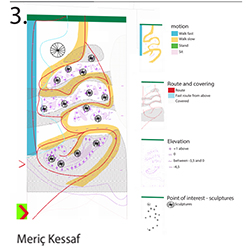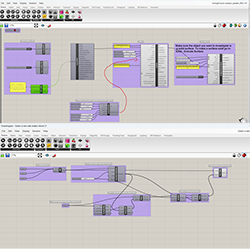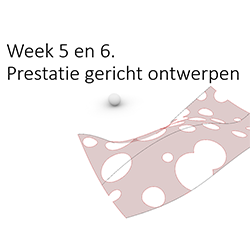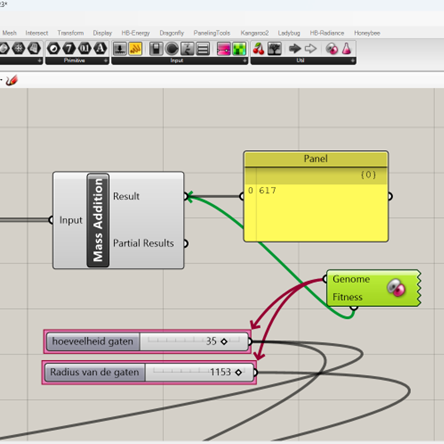BK3OV3 - Parametrisch Ontwerpen
Introduction:
BK3OV3 is an introduction to design with the aid of a computer. This course is divided into 5 parts in which five important themes of digital design possibilities for designers are discussed. At the end of the process, it yields a design for a deepened sculpture garden for the Escher museum in The Hague.




In the first four weeks, you will argue the design based on visual, functional and spatial arguments, where navigating between 2D-3D is important. In the 5th week we introduce performance-oriented design, in which you analyze the 3D model by means of simulations. In the 7th week, we identify variables that influence the analyzed performance and you create a parametric design to promote that performance Using artificial intelligence (AI). During the 9th week you will work out the details of the design further, we will delve further into the use of AI in the design process.
During the next 10 weeks, the comparison between analog and digital design is central. All design questions are approached in the context of digital design. Designing in the computer offers the convenience and efficiency to carry out the research between 2D-3D design comprehensively and thoroughly. Generating various alternatives and optimizing performance using parametric design and AI often influences design choices in a positive way. Matching the spatial experience of the 3D design is also strongly used during this course. Designing in the computer is primarily a systematic process, based on a logical sequence of geometry transformations and the creation of relationships between those geometries. To learn how to design in the computer, it is important that you learn a systematic way of thinking.
This course offers one of many ways to implement this systematic thought process. The assignment, the galvanizing of the sculpture garden is a conscious choice. Not only because of keeping the square intact, but also to focus on making space and not shape. The aim of the assignment is to define the relationship between 3D architectural objects (walls, floors, plateaus, pillars, roofs, etc.) and the artificial landscape in which they are located, through a 2D-3D exploration applied in the design of the sculpture garden. With this you try to introduce groundbreaking programmatic possibilities to an engaging environment and create compositions to promote the spatial experience of the design.

BK3OV3: Concept:
The complexity of these designs lies not in the form itself, but in the method that generates the coherence between forms and also leads to a high-quality architectural space.
As a basis for this we use the transformation of a 2D functional scheme into a 3D space. In this way we try to make it clear to you to think spatially about proportions and relationships between the abstract elements of your design from the beginning of the design process.
Every choice during this process is made on the basis of functional (program of requirements, circulation, sunlight & shadow analysis), spatial, urban planning and building physics arguments. See assignment descriptions for a detailed explanation.
In the first instance, the imposition of the functional schema will be interpreted by many as a limitation. However, experience will show that in the design process, limitations actually promote creativity. In practice, too, it is often the frictions between the many limitations that lead to unexpected, ingenious solutions and generate the most insane architecture. Therefore, use the abstract scheme for inspiration, as an abstract representation of your design concept, not as a direct representation of the geometry.


Analog vs. Digital Design Process
The process of designing in the computer is in some respects very similar to designing on paper. Also in the computer you generally work from coarse to fine. During the design process, more accurate and neater drawings are made. The first sketch is at most used as a basis for the next further elaborated drawing. During the design process in the computer, the digital models are also regularly remodeled, similar to the use of cardboard sketch models, or as sketch roll: recreating the drawing is usually less work and better than adjusting the old drawing. Re-modeling also increases the understanding of the design and can lead to new ideas.
The Parametric Design that we focus on in this course is an iterative process. You make a design decision, you analyze it in context and make improvements based on that analysis. So there is a relationship between analyzing the design decisions and adjusting the design. To effectively support this process, some design software has a so-called parametric structure. This means that the design can be adjusted not only by adjusting shape directly, but by adjusting values and formulas that are used to generate the shape.
In a parametric design environment, you record relationships between the different parts, comparable to mathematical formulas. These can be simple numerical relationships, such as a distance between two parts, but also more complex formulas or conditional dependencies. You make a kind of 'recipe', where there is still room to vary with precise quantities. In the example above, the triangle and the two circles are inherently connected to each other. A change in the diameter of one of the circles has a direct effect on the dimensions of the other two elements, based on the order and dependence of the elements.






